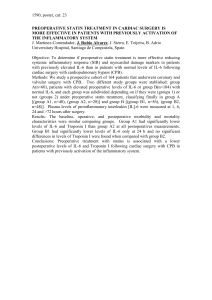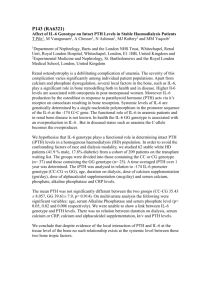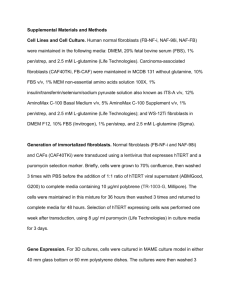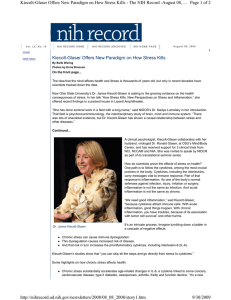How Stress Kills Janice Kiecolt - Glaser, PhD
advertisement
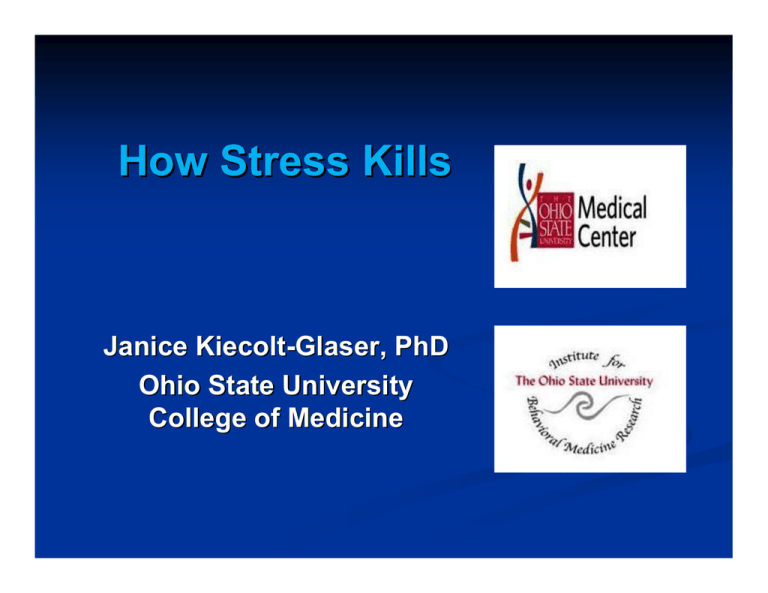
How Stress Kills Janice Kiecolt-Glaser, PhD Ohio State University College of Medicine “Oh, that’s Edward and his fight or flight mechanism.” Glaser & Kiecolt-Glaser: Nature Reviews Immunology, 2005 Glaser & Kiecolt-Glaser: Nature Reviews Immunology. 2005 Dementia family caregiving as a chronic stressor “The 88-year old former airline pilot had been ill for five years, during which time his cognitive abilities had steadily deteriorated. At times he did not recognize his wife and accused her of being a stranger. He could only follow the most simple of commands. His moods were extremely labile, with frequent crying spells and occasional outbursts of anger. He often followed his wife around the house, interrupting her activity with questions and demands. Urinary incontinence and night time agitation were bothersome problems. He often paced at night, occasionally leaving the house and becoming lost... His wife of forty years now devoted her time to looking after her husband. She rarely left home except to do necessary shopping or bill paying, and rarely invited neighbors or friends to her home because of embarrassment about her husband’s behavior.” Barnes et al., Journal of the American Geriatrics Society, 1981 CAREGIVERS, COMPARED TO CONTROLS: Poorer blastogenic response to mitogens (PHA, Con A) Poorer blastogenic response to HSV-1 Poorer T-cell receptor-induced blastogenesis using a monoclonal antibody to the T-cell receptor Lower percentages of IL-2 receptor positive PBLs after mitogen stimulation Enhancement of natural killer cell lysis by cytokines: –(No difference in NK lysis without cytokines) –Poorer response with gamma interferon –Poorer response with IL-2 Higher antibody titers to Epstein-Barr virus (EBV) and HSV-1, i.e., poorer control of latent herpesviruses Lower IL-1b Higher plasma ACTH Lower growth hormone mRNA Elevated circulating nerve growth factor (NGF) Shifts in Th1/Th2 cytokine responses More respiratory infections, more days ill Delayed wound healing Poorer antibody and T-cell responses to influenza vaccine Poor antibody response to pneumococcal pneumonia vaccine CAREGIVERS’ ANTIBODY RESPONSES TO INFLUENZA VACCINE WERE SUBSTANTIALLY POORER THAN WELLMATCHED NON-CAREGIVERS Kiecolt-Glaser, Glaser, Gravenstein, Malarkey, Sheridan: Proceedings of the National Academy of Sciences, USA, 1996 Replication with caregivers published by Vedhara et al. in Lancet, 1999 PNEUMOCOCCAL ANTIBODY TITERS 6.00 Former Caregivers Current Caregivers Controls Antibody Titers (log 10) 5.50 5.00 4.50 4.00 3.50 3.00 Baseline 2 weeks 1 month 3 months 6 months Glaser, Sheridan, Malarkey, MacCallum, & Kiecolt-Glaser : Chronic stress modulates the immune response to a pneumococcal pneumonia vaccine. Psychosomatic Medicine, 2000 Recent study with younger parental caregivers: Gallagher, Phillips, Drayson, Carroll Vaccine responses provide a proxy for responses to infectious disease Multiple labs have shown stress-related alterations in both antibody and T-cell responses to viral and bacterial vaccines including Hepatitis B Influenza virus Pneumococcal pneumonia Rubella Meningitis C conjugate Tetanus STRESS SLOWS WOUND HEALING Caregivers took an average of 24% longer than well-matched controls to heal the same small, standardized wound. Kiecolt-Glaser, Marucha, Malarkey, Mercado, & Glaser: Lancet, 1995 ORAL WOUND HEALING AND ACADEMIC STRESS SUBJECTS: 11 dental students (9 men, 2 women, average age=24.36) DESIGN: Two punch biopsy wounds were placed on the hard palate -at the end of summer vacation -three days before the first major exam of the term (contralateral side) Psychological and health behavior data were collected at each time point Each student served as her or his own control Pain/discomfort ratings were low, with 95% reporting mild or no discomfort Marucha, Kiecolt-Glaser, & Favagehi: Psychosomatic Medicine, 1998 Differences in stress between the two wounds Perceived Stress Score 30 20 10 0 First Wound 3 Days Post Vacation Second Wound 3 Days Post (Exam Day) Exams Marucha, Kiecolt-Glaser, & Favagehi: Psychosomatic Medicine, 1998 Days to heal for each of the 11 students; no student healed as rapidly during exams, with the average student taking 40% ( 3 days) longer 16 DAYS TO HEAL 14 12 10 8 6 4 2 0 VACATION EXAMS Marucha, Kiecolt-Glaser, & Favagehi: Psychosomatic Medicine, 1998 Stress increases susceptibility to wound infections: Compared to control mice, restraint stress delayed wound healing by 30% and caused a 2-5 log increase in opportunistic bacteria (e.g., Staphylococcus aureus) By day 7, 85.4% of restraint-stress mice had bacterial counts predictive of infection, vs. 27.4 of controls Rojas, Padgett, Sheridan, Marucha: Brain, Behavior, and Immunity 2002 “…Healing is a living process, greatly under the influence of mental conditions. It has often been found that the same wound received in battle will do well in the soldiers that have beaten, that would prove fatal in those that have just been defeated.” --Oliver Wendell Holmes Infection and Trauma Trigger the Inflammatory Response Inflammatory mechanisms are critical to resolving infections and repairing tissue damage Proinflammatory cytokines attract immune cells to sites of infection or injury, and activate the cells to respond to the insult Chronic infectious processes or chronic wounds can provoke persistent inflammation (e.g., periodontal disease, urinary tract infections) Chronic or Recurring Infections Can Provoke Pathological Changes Low levels of persistent inflammation (higher levels of proinflammatory cytokines) may be provoked by chronic infectious processes including: periodontal disease urinary tract infections chronic pulmonary disease Proinflammatory cytokines cytokines Proinflammatory • Tumor necrosis factor-α (TNF-α ) • Interleukin 1 (IL-1) • Interleukin 6 (IL-6) • IL-6 directly promotes production of Creactive protein (CRP), an important risk factor for cardiovascular disease Changes in circulating hormones and IL-6 with aging Papanicolaou et al. Annals of Internal Medicine 1998 AGE -ASSOCIATED DISEASES AGE-ASSOCIATED DISEASES LINKED LINKED TO TO PROINFLAMMATORY PROINFLAMMATORY CYTOKINES CYTOKINES Cardiovascular disease Osteoporosis Arthritis Type 2 diabetes Certain cancers (including multiple myeloma, non-Hodgkin’s lymphoma, and chronic lymphocytic leukemia) Periodontal disease Frailty and functional decline Higher plasma concentrations of IL-6 increase the risk of future myocardial infarction among apparently healthy men Prospective study involving 14,916 apparently healthy men with a 6-year follow-up Baseline IL-6 in 202 participants who subsequently had an MI and 202 matched for age and smoking status who did not report vascular disease during follow-up Men in the highest quartile at entry had a relative risk 2.3 times higher than those in the lowest quartile (95% CI 1.3 to 4.3, P=0.005); for each quartile increase in IL-6, there was a 38% increase in risk (P=0.001) . The relationship persisted after controlling for CRP. Ridker et al. Circulation 2000 IL-6 is prospectively associated with both all-cause and cardiovascular disease mortality over 3 years Age-adjusted all-cause mortality rates/1000 person-years by IL-6 levels, history of CVD, and follow-up period. Figures on bars are numbers of deaths and subjects at risk. Volpato et al., 2001, Circulation Elevated levels of CRP and IL-6 predicted the development of type 2 diabetes after adjustments for BMI, family history of diabetes, smoking, exercise, alcohol, and hormone replacement therapy. Pradhan et al. JAMA 2001 Incidence rates of mobility-disability over the 4-year follow-up according to deciles of IL-6 serum level. Ferrucci et al: J Amer Geriatrics Soc 1999 Chronic or Recurring Infections Can Provoke Pathological Changes Low levels of persistent inflammation may be provoked by chronic infectious processes including periodontal disease urinary tract infections chronic pulmonary disease chronic renal disease Inflammation Impacts Cancer: Pathways Aggarwal et al. Inflammation and cancer: How hot is the link? Biochem Pharmacol. 2006 Stress/depression Immune dysregulation Enhanced risk of infection/prolonged infections/delayed wound healing Increased proinflammatory cytokine production Acute psychological stressors can directly provoke transient increases in proinflammatory cytokines Excellent meta-analysis: Steptoe, Hamer, Chida, Brain, Behavior, and Immunity, 2007 Psychological stress induces the transcription factor NF-ΚB in healthy volunteers undergoing a laboratory speech stressor. Bierhaus et al., PNAS, 2003 Acute stress enhances systemic proinflammatory cytokine production while inhibiting local production at wound sites Couples were admitted twice to the GCRC (hospital research unit), 24 hours each admission First admission: Structured social support interaction Second admission: Structured conflict (marital disagreement) Both admissions: blister wounds before the interaction, wore wound chambers 22 hours, assessed proinflammatory cytokine secretion at wound sites and plasma Couples’ blister wounds healed more slowly, and local cytokine production (IL-6, TNF-α, IL-1β) was also lower at wound sites following marital conflicts than after social support interactions. Hostile couples showed larger increases in plasma IL-6 and TNF-α the morning after a conflict than after a social support interaction compared to less hostile couples, and hostile couples took an average of two days longer to heal wounds. Kiecolt-Glaser, Loving, Stowell, Malarkey, Lemeshow, Dickinson & Glaser (2005). Archives of General Psychiatry. Stress/depression Immune dysregulation Enhanced risk of infection/prolonged infections/delayed wound healing Increased proinflammatory cytokine production STRESS/DEPRESSION ENHANCE PROINFLAMMATORY CYTOKINE PRODUCTION Major depression increased secretion of proinflammatory cytokines; treatment with antidepressants decreases secretion (Maes; Irwin; Miller) Depressive symptoms were linked to increased IL-6 in community samples of older adults (Dentino et al., 1999) Depressed mood was associated with higher levels of serum IL-6, TNF-α, and CRP among older adults ages 70-79 (Penninx et al., 2003) Chronic stressors like caregiving have been associated with heightened IL-6 compared to noncaregiving controls (Lutgendorf et al.; Kiecolt-Glaser et al.; Glaser et al.) Acute stressors enhance production of proinflammatory cytokines (Goebel et al., 2000; Steptoe et al., 2001) 5 p < .001 p< .005 p< .05 p < .001 4 p < .001 7 12 10 8 6 4 2 0 ** * IL-6 pg/ml POMS DEPRESSION SCALE Interleukin -6 in 4 Groups of Community Women Interleukin-6 6 Groups (mean age) 3 2 1 0 Lutgendorf et al., Journals of Gerontology, 1999 Young women (40) Older controls (76) Movers (80) Caregivers (71) Longitudinal community study spanning 6 years: 119 caregivers 106 noncaregivers (mean age at study entry, 71) Key Measures: IL-6 in frozen plasma samples, 2x/year Health behaviors associated with IL-6 Depressive symptoms Kiecolt-Glaser, Preacher, MacCallum, Atkinson, Malarkey, & Glaser (2003). Proceedings of the National Academy of Sciences, USA MODELED CHANGE IN IL-6 IN CAREGIVERS VS. NONCAREGIVERS IL-6 is represented as a linear function of age; each individual's pattern of change is represented by a straight line defined by an intercept (predicted level of IL-6 at age 55) and slope (predicted change in IL-6 per year). 0.9 7.94 Caregivers Controls 6.31 0.7 5.01 0.6 3.98 0.5 3.16 0.4 2.51 0.3 2.00 0.2 1.58 0.1 Predicted IL-6 (raw), pg/ml Predicted IL-6 (log10), pg/ml 0.8 ¾3.19 = upper quartile, epidemiologic studies 1.26 55 60 65 70 75 80 85 90 95 Age Caregivers' average rate of increase in IL-6 was about four times as large as that of noncaregivers, and the two slopes were significantly different from one another, p = .01. Compared to noncaregivers, men and women who provide care to a spouse with a stroke or a dementia are at greater risk for developing diabetes becoming hypertension coronary heart disease (CHD) Lee et al., 2003; Shaw et al., 1999; Vitaliano et al., 1996, 2002 A large population-based study of the elderly drawn from a random, stratified sample: relative risk for allcause mortality among strained caregivers was 63% higher than noncaregiving controls. These data represent the “best case” scenario, with caregiving defined very broadly (Schulz & Beach, JAMA, 1999) WHAT HAPPENS WHEN CAREGIVING ENDS? Normal bereavement: higher incidence of depression and anxiety in widows and widowers within the first several months after the spouse’s death compared to nonbereaved controls. These group differences are typically not significant in follow-up data collected one to two years later (Harlow et al., 1991; Lund et al., 1989; Thompson et al., 1991). Thus—caregivers should look no different than noncaregivers ~2 years after the spouse’s death On entry into this portion of the longitudinal study, 28 of the caregivers' spouses had already died; an additional 50 of the 119 spouses died during the 6 years of this study. Selected for this analysis: continuous caregivers vs. those bereaved 3 or more years Former caregivers’ average rate of annual change in IL-6 did not differ from that of current caregivers, even several years after the death of the impaired spouse Predicted IL-6 (log10), pg/ml 1.0 Current Caregivers Former Caregivers Controls 0.8 0.6 0.4 0.2 0.0 55 60 65 70 75 80 85 90 95 Age Kiecolt-Glaser, Preacher, MacCallum, Atkinson, Malarkey, & Glaser (2003). Proceedings of the National Academy of Sciences, USA Stress and depression can prime the inflammatory response, promoting larger cytokine increases in response to subsequent stressors and/or minor infectious challenges Prior stress produces exaggerated proinflammatory cytokine responses to infection. Compared to nonstressed controls, LPS exposure resulted in larger and more rapid proinflammatory cytokine induction in stressed rats. Johnson et al: Brain, Behavior, and Immunity, 2002 Among women who had just given birth, those with a prior history of major depression showed greater increases in serum IL-6 and the soluble IL-6 receptor after delivery than women without a similar depression history Maes et al: Journal of Affective Disorders, 2001 Higher levels of depressive symptoms were associated with higher levels of IL-6, as well as an amplified and prolonged inflammatory response following influenza vaccination Glaser et al. Arch Gen Psychiatry 2003 Patients with major depression vs. nondepressed controls: Greater stress-induced IL-6 and NF-κB activation More depressive symptoms=greater change Pace et al. Am J Psychiatry 2006 STRESS STRESS PROMOTES PROMOTES POOR POOR HEALTH HEALTH BEHAVIORS BEHAVIORS THAT THAT ENHANCE ENHANCE PROINFLAMMATORY PROINFLAMMATORY CYTOKINE CYTOKINE PRODUCTION PRODUCTION High fat diet Less exercise Poorer sleep Smoking Sleep deprivation alters normal nocturnal increases in IL-6, contributing to immune system dysregulation. Redwine et al.: J Clin Endocrinol Metab, 2000 “…a good night's sleep is associated with decreased daytime secretion of IL-6 and a good sense of well-being…” Vgontzas et al.: J Clin Endocrinol Metabol, 1999 HEALTH-RELATED BEHAVIORS MAKE A DIFFERENCE: Individuals with a higher body mass index have higher levels of IL6 and CRP; Papanicolaou, Wilder, Manolagas, Chrousos: Ann Intern Med. 1998 Abdominal adipose tissue may secrete up to three times as much IL-6 as other subcutaneous fat tissues; Browning; Proc Nutri Soc 2003 Central adiposity may be associated with larger stress-induced cytokine responses; Brydon,, Wright, O'Donnell, Zachary, Wardle, Steptoe, Int J Obes 2007 Moderate Physical Activity May Help Attenuate Chronic Inflammation Lower basal IL-6 and CRP in well-trained swimmers than healthy controls (Espersen et al. Scand J Med Sci Sports 1996) High levels of recreational activity were associated with lower IL-6 and CRP in healthy older adults (Reuben et al. J Am Geriatrics Soc 2003) 35% reduction in CRP after 6 months of supervised moderate exercise in men and women at risk for future heart attack (Smith et al. JAMA 1999) Stress/depression Immune dysregulation Enhanced risk of infection/prolonged infections/delayed wound healing Increased proinflammatory cytokine production Interventions that diminish stress or depression and/or inflammation may enhance health in part through their positive impact on immune and endocrine regulation Nutritional Neuroscience Neuroscience and and Nutritional Psychoneuroimmunology: Psychoneuroimmunology: Interdisciplinary Science Science at at the the Interdisciplinary Crossroads Crossroads Omega-3 and omega-6: implications for depression, cardiovascular disease, and inflammation The balance of omega 6 and omega 3 (the n-6:n-3 ratio) influences inflammation omega-6 (n-6) from refined vegetable oils (e.g., corn, sunflower, safflower) omega-3 (n-3) from fish, fish oil, walnuts, wheat germ, and flax seed products Competition for metabolizing enzymes means that higher proportions of omega6 vs. omega-3 will lead to more inflammatory eicosanoids. Historical Dietary Changes: Leaves to Seeds Omega-3 (n-3) polyunsaturated fatty acids (PUFAs): Fish, fish oil, walnuts, wheat germ, flax seed products Arachidonic acid (AA) derived (omega-6 or n-6) eicosanoids (primarily from refined vegetable oils such as corn, soy, sunflower, and safflower) Before early 1900s, dietary n-6 : n-3 ratios were ~ 2:1 or 3:1…then processed vegetable seed oils entered the diet Contemporary North American dietary ratios: 15-17:1; Europe, UK: 14:1 Leaf A, Weber PC: Am J Clin Nutr 1987 Leaves to Seeds In addition to the broad adoption of refined vegetable oils… Industrial meat is raised on more seeds and fewer leaves than preindustrial meat, so it has more omega-6 and less omega-3 Official dietary advice since the 1970s has promoted polyunsaturated vegetable oils (particularly corn and soy), high in omega-6 When oils are hydrogenated to make them more stable, omega-3s are eliminated 1123 people, ages 20-98, Tuscany, Italy Ferrucci et al. Relationship of plasma polyunsaturated fatty acids to circulating inflammatory markers. J Clinical Endocrinology and Metabolism, 2006 Possible consequences of the historical dietary shift from leaves to seeds: increased depression and cardiovascular disease Significant inverse relationships between annual fish consumption and prevalence of major depression Very similar pattern for cardiovascular disease Hibbeln: Fish consumption and major depression. Lancet 1998 Depression and omega-3 intake Depressed patients have lower average plasma levels of omega-3 PUFAs than nondepressed controls Significant relationships between lower omega-3 plasma levels and greater negative mood have been documented in psychiatric and nonpsychiatric populations Clinical trials (mostly addon designs) are encouraging Possible Biological Mechanisms: Impact of Omega-3 on Psychiatric Disorders Increased serotonergic neurotransmission Alterations in dopaminergic function Regulation of corticotropin-releasing factor Inhibition of protein kinase C Suppression of phosphatidylinositol-associated second messenger activity Modulation of heart rate variability via vagal mechanisms Increased dendritic arborization and synapse formation Prevention of neuronal apoptosis Improved cerebral blood flow Competition of EPA with AA for enzymatic activity and resultant reduction of the inflammatory response From: Freeman et al. J Clin Psychiatry, 2006 Depression, cardiovascular disease, and omega-3 Large epidemiological studies: inverse relationships between omega-3 levels and cardiovascular disease Major depression is associated with lower omega-3 fatty acid levels in patients with recent acute coronary syndromes Frasure-Smith et al. Biol Psychiatry, 2004 Possible Mechanisms Preventing arrhythmias Decreasing platelet aggregation Decreasing plasma triglycerides Moderately decreasing blood pressure Reducing atherosclerosis Small increase in HDL cholesterol Modulating endothelial function Decreasing proinflammatory eicosanoids National Academy of Sciences, 2002 HOW DIET INTERACTS WITH STRESS AND DEPRESSION: NF -κB ACTIVATION NF-κB Key omega-3 PUFAs, EPA and DHA, reduce NF-κB activation Zhao 2004 J Am Coll Nutr NF-κB activation activation NF-κB PROINFLAMMATORY PROINFLAMMATORY CYTOKINE CYTOKINE PRODUCTION PRODUCTION Depression and psychological stress promote NF-κB activation Bierhaus et al. 2003, PNAS; Pace et al. 2006, Am J Psychiatry EVIDENCE: DIETARY INTAKE INTERACTS WITH EXAM STRESS Students who had higher n-6:n-3 ratios (above the mean) before exams demonstrated greater TNF-α production by LPS and mitogenstimulated PBLs during exams than those with lower ratios Maes et al., 2000, Biol Psychiatry The data suggest that n-6:n-3 ratios influence the proinflammatory response to stressors. Because TNF-α and IL-6 are produced by a variety of types of cells, serum cytokine levels may better reflect the overall inflammatory profile than stimulated PBLs. Community sample, sample, older older adults adults Community 43 healthy older adults (mean age = 66.67, SD=10.09) CES-D (depressive symptoms) 7.41 (SD=5.86) omega-6 38.53 (SD=5.98) omega-3 2.71 (SD=0.84) omega-6:omega-3 14.13 (SD=3.42), excluding two participants who had extreme ratios of 49.35 and 168.18 Kiecolt-Glaser, Belury, Porter, Beversdorf, Lemeshow, Glaser: Depressive symptoms, omega6:omega-3 fatty acids, and inflammation older adults. Psychosomatic Medicine, 2007 Higheromega-6:omega-3 omega-6:omega-3ratios ratiosand andhigher higherlevels levelsof ofdepressive depressive Higher symptomspredicted predictedhigher higherlevels levelsof ofSERUM SERUMTNF-α TNF-αand andIL-6 IL-6than than symptoms eitheralone alone either 43 healthy older adults (mean age = 66.67, SD=10.09) Depressive Depressive symptoms symptoms X X n-6:n-3 n-6:n-3 ratios: ratios: 13% 13% of of variance variance Depressive Depressive symptoms symptoms X X n-6:n-3 n-6:n-3 ratios: ratios: 31% 31% of of variance variance Predicted cytokine levels were fairly consistent across n-6:n-3 ratios when depressive symptoms were low; higher n-6:n-3 ratios were associated with increasingly elevated cytokine levels as depressive symptoms increased for TNF-α and IL-6. Kiecolt-Glaser, Belury, Porter, Beversdorf, Lemeshow, Glaser: Depressive symptoms, omega6:omega-3 fatty acids, and inflammation in older adults. Psychosomatic Medicine, 2007. How big are these effects? A 20% increase in the median omega -6: omega -3 omega-6: omega-3 ratio of 14 in the presence of low depressive symptoms (CES-D = 3) moderate depressive symptoms (CES-D = 9) 2% increase in IL-6 no increase in TNF-α. 25% increase in IL-6 30% increase TNF-α. high depressive symptoms (CES-D = 20) 85% increase in IL-6 115% increase in TNF-α. 120% 100% 80% IL-6 TNF-α 60% 40% 20% 0% CES-D = 3 Low CES-D = 9 Moderate CES-D=20 High Depressive Symptoms Kiecolt-Glaser, Belury, Porter, Beversdorf, Lemeshow, Glaser: Depressive symptoms, omega-6:omega-3 fatty acids, and inflammation older adults. Psychosom Med, 2007 IMPLICATIONS IMPLICATIONS Diets with high omega6:omega-3 ratios may enhance risk for both depression and inflammatory diseases, particularly when individuals already have elevated levels of depressive symptoms. Randomized controlled trials are needed…! NIH-funded randomized controlled clinical trials Medical students (NCCAM) Healthy community adults, ages 40-88 (NIA) Interdisciplinary Interdisciplinary teams teams that that assess assess psychological psychological and and biological biological outcomes outcomes are are essential essential Janice JaniceK. K.Kiecolt-Glaser, Kiecolt-Glaser,Ph.D. Ph.D. Ronald RonaldGlaser, Glaser,Ph.D Ph.D William WilliamB. B.Malarkey, Malarkey,M.D. M.D. Stanley StanleyLemeshow, Lemeshow,Ph.D. Ph.D. Martha MarthaBelury, Belury,Ph.D. Ph.D. “WE COLLABORATE. I’M AN EXPERT, BUT NOT AN AUTHORITY, AND DR. GELBIS IS AN AUTHORITY, BUT NOT AN EXPERT.”
